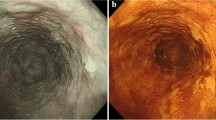Abstract
Background
Dysplastic squamous epithelium is a precancerous lesion for squamous cell carcinoma. It is often present in the esophagus and head and neck region, and can be visualized as a Lugol-voiding lesion (LVL) by iodine chromoendoscopy. However, effective treatment for such dysplastic epithelia has not yet been developed.
Methods
Between March 2008 and July 2011, 40 consecutive patients with advanced esophageal squamous cell carcinoma were treated by two cycles of neoadjuvant chemotherapy (NAC) (5-fluorouracil, 800 mg/m2, d 1–5; cisplatin, 80 mg/m2, d 1: q 21 days) at Kyoto University Hospital, and received iodine chromoendoscopy both before and after NAC. Iodine chromoendoscopy findings were divided into 4 groups: group A, absence of LVLs; group B, several (≤10/one endoscopic view) small (≤5 mm) LVLs; group C, many (≥10/one endoscopic view) small (≤5 mm) LVLs; group D, numerous irregular-shaped multiform LVLs. Group C and D are defined as multiple LVLs. Endoscopic changes of LVLs before and after NAC were investigated retrospectively.
Results
Before NAC, 6, 12, 9, and 13 cases were classified in group A, B, C, and D, respectively. All cases in group A before NAC remained in group A after NAC. Multiple LVLs (group C and D) were significantly improved in 17 of 22 patients (77.3 %), while several small LVLs (group B) were improved in only 4 of 12 cases (33.3 %) (p = 0.025 by Fisher’s exact test).
Conclusions
Multiple dysplastic lesions tended to improve by chemotherapy. In contrast, there was little change in the mucosa with fewer dysplastic lesions after chemotherapy. These data show that chemotherapy has the potential to eliminate precancerous lesions.




Similar content being viewed by others
References
Parkin DM, Bray F, Ferlay J, Pisani P. Global cancer statistics, 2002. CA Cancer J Clin. 2005;55:74–108.
Secretan B, Straif K, Baan R, Grosse Y, El Ghissassi F, Bouvard V, et al. A review of human carcinogens—part E: tobacco, areca nut, alcohol, coal smoke, and salted fish. Lancet Oncol. 2009;10:1033–4.
Slaughter DP, Southwick HW, Smejkal W. Field cancerization in oral stratified squamous epithelium; clinical implications of multicentric origin. Cancer. 1953;6:963–8.
Mori M, Adachi Y, Matsushima T, Matsuda H, Kuwano H, Sugimachi K. Lugol staining pattern and histology of esophageal lesions. Am J Gastroenterol. 1993;88:701–5.
Muto M, Takahashi M, Ohtsu A, Ebihara S, Yoshida S, Esumi H. Risk of multiple squamous cell carcinomas both in the esophagus and the head and neck region. Carcinogenesis. 2005;26:1008–12.
Hori K, Okada H, Kawahara Y, Takenaka R, Shimizu S, Ohno Y, et al. Lugol-voiding lesions are an important risk factor for a second primary squamous cell carcinoma in patients with esosphageal cancer or head and neck cancer. Am J Gastroenterol. 2011;106:858–66.
Hirao M, Ando N, Tsujinaka T, Udagawa H, Yano M, Yamana H, et al. Influence of preoperative chemotherapy for advanced thoracic oesophageal squamous cell carcinoma on perioperative complications. Br J Surg. 2011;98:1735–41.
Muto M, Hironaka S, Nakane M, Boku N, Ohtsu A, Yoshida S. Association of multiple Lugol-voiding lesions with synchronous and metachronous esophageal squamous cell carcinoma in patients with head and neck cancer. Gastrointest Endosc. 2002;56:517–21.
Japan Esophageal Society (ed) (2008) Japan Classification of esophageal cancer, 10th edn. Kanehara & Co., Ltd., Tokyo.
Voegeli R (1966) Schiller’s iodine test in the diagnosis of esophageal diseases. Preliminary report. Pract Otorhinolaryngol (Basel) 28:230–9.
Kouzu T. Clinical meaning of Lugol non-staining lesion from the endoscopical point of view. Stomach Intestine. 1994;29:883–9.
Shimizu Y, Tukagoshi H, Fujita M, Hosokawa M, Kato M, Asaka M. Metachronous squamous cell carcinoma of the esophagus arising after endoscopic mucosal resection. Gastrointest Endosc. 2001;54:190–4.
Shimizu Y, Tsukagoshi H, Fujita M, Hosokawa M, Watanabe A, Kawabori S, et al. Head and neck cancer arising after endoscopic mucosal resection for squamous cell carcinoma of the esophagus. Endoscopy. 2003;35:322–6.
Kobayashi M, Kawachi H, Takizawa T, Uchida K, Sekine M, Kumagai J, et al. p53 Mutation analysis of low-grade dysplasia and high-grade dysplasia/carcinoma in situ of the esophagus using laser capture microdissection. Oncology. 2006;71:237–45.
Limburg PJ, Wei W, Ahnen DJ, Qiao Y, Hawk ET, Wang G, et al. Randomized, placebo-controlled, esophageal squamous cell cancer chemoprevention trial of selenomethionine and celecoxib. Gastroenterology. 2005;129:863–73.
Ando N, Iizuka T, Ide H, Ishida K, Shinoda M, Nishimaki T, et al. Surgery plus chemotherapy compared with surgery alone for localized squamous cell carcinoma of the thoracic esophagus: a Japan Clinical Oncology Group Study—JCOG9204. J Clin Oncol. 2003;21:4592–6.
Bleiberg H, Conroy T, Paillot B, Lacave AJ, Blijham G, Jacob JH, et al. Randomised phase II study of cisplatin and 5-fluorouracil (5-FU) versus cisplatin alone in advanced squamous cell oesophageal cancer. Eur J Cancer. 1997;33:1216–20.
Muro K, Hamaguchi T, Ohtsu A, Boku N, Chin K, Hyodo I, et al. A phase II study of single-agent docetaxel in patients with metastatic esophageal cancer. Ann Oncol. 2004;15:955–9.
Scheithauer W, McKendrick J, Begbie S, Borner M, Burns WI, Burris HA, et al. Oral capecitabine as an alternative to i.v. 5-fluorouracil-based adjuvant therapy for colon cancer: safety results of a randomized, phase III trial. Ann Oncol. 2003;14:1735–43.
Sakuramoto S, Sasako M, Yamaguchi T, Kinoshita T, Fujii M, Nashimoto A, et al. Adjuvant chemotherapy for gastric cancer with S-1, an oral fluoropyrimidine. N Engl J Med. 2007;357:1810–20.
Stoner GD, Wang LS, Chen T. Chemoprevention of esophageal squamous cell carcinoma. Toxicol Appl Pharmacol. 2007;224:337–49.
Acknowledgments
This work was supported in part by management expenses grants from the Government to the National Cancer Center (grant number 101106).
Conflict of interest
The authors have no conflict of interest.
Author information
Authors and Affiliations
Corresponding author
Rights and permissions
About this article
Cite this article
Yukawa, Y., Muto, M., Amanuma, Y. et al. Elimination of esophageal multiple precancerous lesions by chemotherapy: potential chemoprevention of metachronous multiple cancer development after curative treatment. Esophagus 9, 203–209 (2012). https://doi.org/10.1007/s10388-012-0339-3
Received:
Accepted:
Published:
Issue Date:
DOI: https://doi.org/10.1007/s10388-012-0339-3




